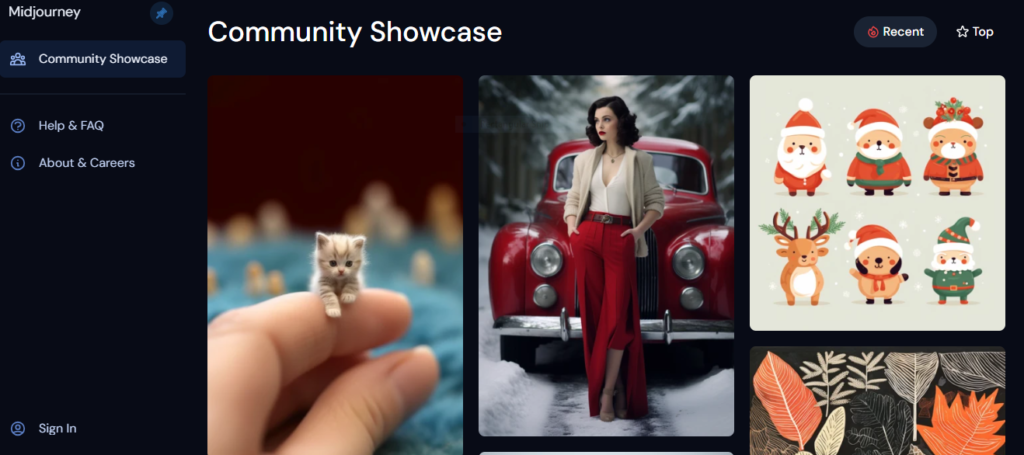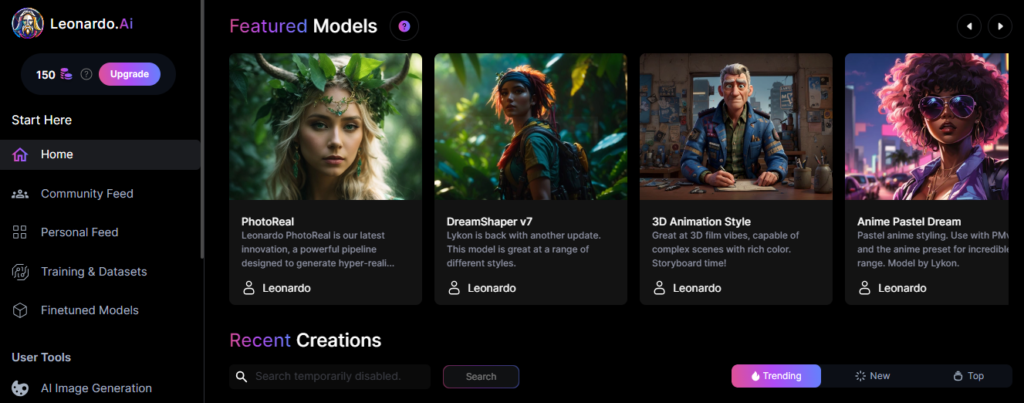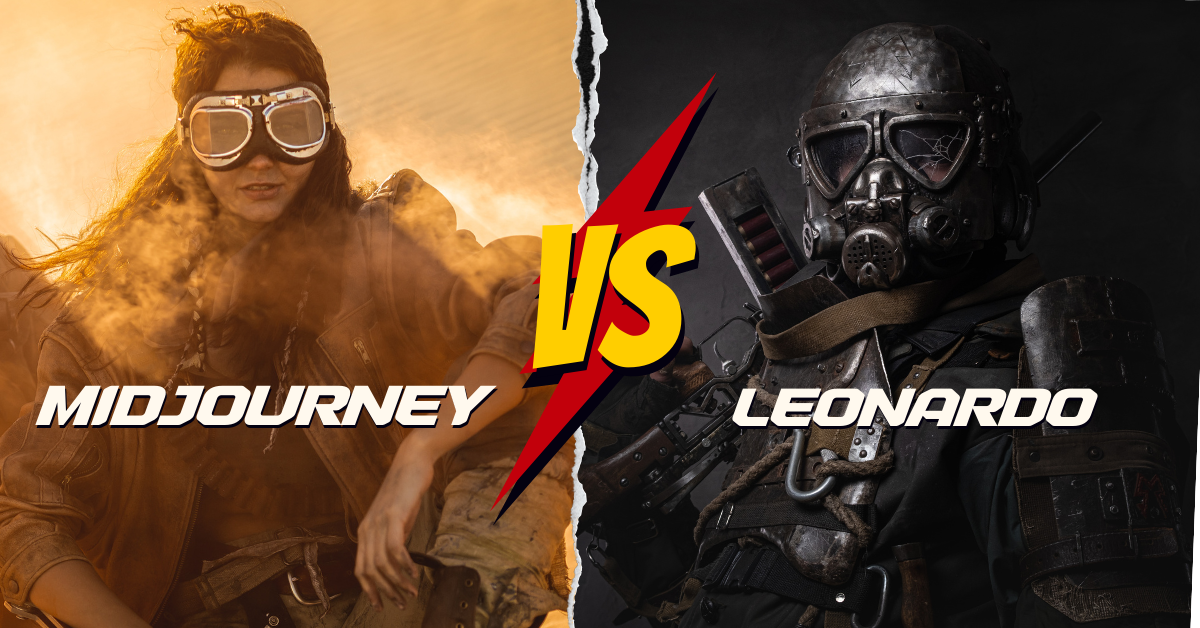Midjourney and Leonardo are two leading AI art generators, leveraging artificial intelligence to transform text prompts into images. These versatile tools serve a range of purposes, from entertainment and education to sparking creativity and inspiration. Nevertheless, when assessing AI art generators, it’s essential to recognize that not all of them are of equal capability and quality. In this article, we will conduct a comparative analysis of Midjourney and Leonardo, shedding light on their respective features and strengths.
Table of Contents
What are Midjourney and Leonardo?
Midjourney and Leonardo are prominent AI art generation platforms, each with its own distinct characteristics, user interfaces, and pricing structures.
Midjourney:
Midjourney operates as an AI art generator within the Discord messaging platform. Users engage with Midjourney by entering commands in a designated chat channel. This AI tool utilizes a single model capable of producing images in a wide range of styles and themes, including portraits, landscapes, animals, fantasy, sci-fi, and more. Midjourney boasts advanced functionalities like inpainting, style transfer, and background removal.
To access Midjourney, users subscribe to a paid service, costing $10 per month, which provides unlimited usage. Alternatively, they can experience a trial of Midjourney for a limited time by joining their Discord server and requesting a trial.
Leonardo:
Leonardo, on the other hand, is an AI art generator with its own web-based interface. Users can access Leonardo by visiting the platform’s website and creating an account. Leonardo offers a general AI model as well as several fine-tuned models, tailored for generating images in specific domains like anime, cartoons, pixel art, sketches, and more. Furthermore, Leonardo empowers users with the ability to customize their generated images by adjusting parameters like image count, dimensions, guidance scale, and more.
Leonardo follows a freemium model, allowing initial access for free with a set token limit. Users can create up to 10 images per day using the general model or up to 5 images per day with the fine-tuned models. Upon reaching their token limit, users can either wait until the following day or purchase additional tokens to continue generating images. Additionally, users have the option to upgrade to a premium membership at a cost of $12 per month, granting them unlimited access to all models and features.
How do Midjourney and Leonardo compare?

In comparing Midjourney and Leonardo, we will evaluate them based on three key criteria: user experience, image quality, and creativity.
User Experience:
User experience encompasses the ease and enjoyment of using an AI art generator, including aspects like interface design, accessibility, functionality, and feedback.
Interface Design:
In terms of interface design, Leonardo holds a distinct advantage over Midjourney. Leonardo boasts a user-friendly and intuitive visual interface that enables users to effortlessly adjust image generation settings and parameters. Furthermore, Leonardo presents results in a scrollable gallery, providing convenient viewing and download options.
Midjourney, in contrast, offers a less intuitive interface that relies on text commands within Discord. Users are required to input their image generation settings using specific syntax and keywords. Additionally, viewing results on Midjourney necessitates the use of a separate app and logging in with a Discord account.
Accessibility:
Accessibility pertains to how easily users can access and use the AI art generator. This criterion encompasses considerations like availability, compatibility, reliability, and security.
Both Midjourney and Leonardo offer good accessibility in terms of availability and compatibility. They are online services accessible from any device with an internet connection and support various languages and text prompt formats.
However, Midjourney exhibits issues related to reliability and security. Since it relies on Discord, its performance and stability are contingent on the chat platform. Users might encounter delays or errors in image generation due to Discord server issues or maintenance. Furthermore, users may have concerns about data privacy and security, as linking their Discord account with Midjourney is required to view results.
In contrast, Leonardo does not face these challenges, as it operates through its web-based interface, independent of third-party platforms. Users can generate images without interruption, given a stable internet connection, and are not obligated to log in with external accounts to access their results.
Functionality
Functionality assesses the AI art generator’s ability to fulfill its primary task of converting text prompts into images efficiently and effectively. Key aspects include speed, accuracy, diversity, and consistency.
Speed and Accuracy:
Both Midjourney and Leonardo excel in terms of speed and accuracy. Both platforms exhibit impressive capabilities in generating images swiftly, typically taking only seconds or a few minutes, depending on the prompt’s complexity. Furthermore, both platforms consistently produce images that align with the descriptions and styles outlined in the prompts.
Diversity and Consistency:
In this regard, Leonardo has a competitive advantage over Midjourney. Leonardo enhances the user experience by offering a wider array of options and ensuring consistency in image generation. It provides a diverse range of models, allowing users to select different domains, styles, and effects for their images. Moreover, users have the flexibility to fine-tune their images by adjusting variables like the number of images generated, dimensions, guidance scale, and other parameters.
Conversely, Midjourney has limited diversity and fewer options for image generation. It primarily relies on a single model, offering users a constrained selection of styles and effects for their images. Users have fewer parameters to manipulate, such as aspect ratio and style weight, resulting in a less versatile experience compared to Leonardo.
Feedback

Feedback encompasses the AI art generator’s ability to interact with users, providing information, guidance, and support. This includes elements like instructions, tips, examples, and customer assistance.
Leonardo:
In terms of feedback, Leonardo holds a slight advantage over Midjourney. Leonardo offers clear and valuable guidance to its users. The platform provides comprehensive instructions, helpful tips, and illustrative examples on how to effectively utilize its features and models. Users can readily access detailed guides and tutorials on Leonardo’s official website. Additionally, Leonardo maintains multiple channels for user support, allowing individuals to reach out to the platform’s team via email or social media for questions or assistance.
Midjourney:
Midjourney, while providing some feedback, falls slightly short of the clarity and helpfulness found in Leonardo. The platform does offer certain guides and tutorials on how to utilize its features and commands, which are available on their Discord server. However, these resources may be less comprehensive and not consistently updated, potentially leaving users with gaps in their understanding. Similarly, users can contact Midjourney’s support team via Discord, but the responsiveness and quality of assistance may vary, with the possibility of users not receiving a prompt or satisfactory response.
Image quality
Image quality refers to how realistic and aesthetic the images generated by the AI art generator are. This includes aspects such as resolution, detail, color, and coherence.
Both Midjourney and Leonardo have good image quality in terms of resolution, detail, color, and coherence. Both platforms can generate high-resolution images with fine details and vivid colors. Both platforms can also generate coherent images that do not have any obvious artifacts or distortions.
However, Leonardo has a slight edge over Midjourney in terms of image quality. Leonardo’s images tend to be more realistic and natural-looking than Midjourney’s images. Leonardo’s images also tend to have more variation and contrast than Midjourney’s images.
Midjourney’s images tend to be more stylized and abstract-looking than Leonardo’s images. Midjourney’s images also tend to have more blur and noise than Leonardo’s images.
Creativity
Creativity involves evaluating the originality and innovation of images generated by the AI art generator, encompassing factors like novelty, diversity, surprise, and expression.
Novelty, Diversity, Surprise, and Expression:
Both Midjourney and Leonardo exhibit commendable creativity by delivering images that possess novelty, diversity, surprise, and expressive qualities. They excel in producing images that are entirely novel, transcending existing real-world or pre-existing image concepts. Furthermore, both platforms generate a diverse array of images that span a wide spectrum of styles and themes, catering to varied user preferences.
In terms of surprise, both Midjourney and Leonardo maintain the capacity to craft images that challenge users’ expectations, sparking creativity and imagination. Additionally, they enable users to express their mood or intentions through the images they generate.
Midjourney’s Edge:
Midjourney, however, holds an advantage over Leonardo in terms of creativity. Midjourney’s images often exhibit a higher degree of originality and innovation when compared to Leonardo’s creations. Furthermore, Midjourney’s images tend to offer greater variation and unpredictability, enhancing the element of surprise for users. This greater degree of novelty and originality can be an enticing aspect for those seeking truly unique and innovative visual outputs.
Leonardo’s images tend to be more conventional and realistic than Midjourney’s images. Leonardo’s images also tend to have more consistency and predictability than Midjourney’s images.
Conclusion
In conclusion, both Midjourney and Leonardo offer impressive AI art generation capabilities, each with its own set of strengths and weaknesses that may cater to different user preferences.
Midjourney shines for users who prioritize creativity and the generation of original and innovative images. While it excels in this aspect, it comes with a trade-off in terms of a less user-friendly interface and a higher price point.
On the other hand, Leonardo appeals to users valuing user experience and image quality. It is proficient at creating realistic and aesthetically pleasing images. However, it may not provide the same level of originality and innovation seen in Midjourney’s output.
Ultimately, the choice between the two depends on the individual user’s priorities and project requirements. It’s advisable for users to explore both platforms during their free trial periods to determine which one aligns better with their specific needs and preferences.




